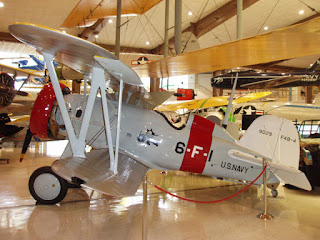 |
Felix the Cat with Charlie Chaplin in
“Felix in Hollywood”
(1923).
Public Domain.
|
Why Felix?
 |
| Insignia for US Navy Fighting Squadron 6 (later VF-31), ca. 1935. National Air and Space Museum. |
Felix the Cat first appeared as "Master Tom" in a 1919 short
directed by Otto Messmer. Felix went on to star in many more films, using his clever
smarts to outwit basically everyone he encountered. The generation that fought
World War II knew him as “a courageous feline who would never give up,” Laura Vocelle
writes (p. 327). Plus, the word felix
in Latin means “lucky” or “successful.” So it is really no surprise that Felix’s image and attitude were adopted for military insignia.
 |
An F4B-4 with Felix the Cat emblem.
Photo by Bill Larkins
[CC BY-SA 2.0, via WikimediaCommons.
|
Origins of the Tomcatters
The strike fighter squadron now known as VFA-31, or the Tomcatters,
began back in 1935 as the VF-1B Shooting Stars. The squadron went through
several designations (the US Navy site
lists them all), with Felix displayed on the squadron’s planes and patches
almost from the beginning. He is shown running while holding a bomb with a lit
fuse. Felix the Cat became the squadron’s official mascot in 1946. They became
known as the Tomcatters in 1948.
 |
Lieutenant “Butch” O’Hare in a Grumman F4F-3 Wildcat,
with
the Felix the Cat emblem visible on the left.
Photograph taken at Naval Air
Station, Hawaii,
April 10, 1942.
US Navy. Public Domain.
|
The squadron was at Pearl Harbor, aboard the USS Enterprise, on December 7, 1941, and was
involved in several crucial battles in the Pacific. Lieutenant Commander Edward
“Butch” O’Hare, the navy’s first flying ace and the first navy man to receive
the Medal of Honor in World War II, flew with the squadron.
After World War II, VF-31 was involved in the Korean War and
Vietnam War.
 |
| F-4J Phantom lands aboard the USS Saratoga, January 8, 1980. It's hard to see, but Felix the Cat is about midway along the plane. (ID:DNSN8204480) [Public domain], via Wikimedia Commons. |
Into the 21st century
VFA-31 and Felix the Cat have flown over Afghanistan and Iraq
during the recent conflicts in those countries. These days, their headquarters
is Naval Air Station Oceana, and they’re flying the F/A-18E Super Hornet.
Given their distinguished history, we can’t help but think
that the smart, cunning cartoon cat named Felix might have brought them some
luck.
 |
Two F/A-18 Super Hornets over Afghanistan,
December 15,
2008. You can see the Felix the Cat
emblem on the tail of the near plane (note the Santa hat).
By Staff Sgt. Aaron Allmon, U.S. Air Force
[Public domain],
via WikimediaCommons.
|
Sources
US Navy. STRKFITRON Three One. “History.” 2013. http://www.public.navy.mil/AIRFOR/vfa31/Pages/History.aspx
L. A. Vocelle. Revered
and Reviled: A Complete History of the Domestic Cat. Great Cat
Publications, 2016.
Wikipedia. “VFA-31.” https://en.wikipedia.org/wiki/VFA-31

What an interesting post. I never knew about The Tomcatters - fascinating.
ReplyDeleteThanks for another great history lesson.
ReplyDeleteThis is so interesting! I'm a huge fan of Felix (and our incredible military!)
ReplyDeleteThat was very interesting.
ReplyDeleteThe writer of this post missed the chance to note the period between when VFA-31 was flying F-4 Phantoms and when they flew F-18 Hornets. In the period between those two airplanes, VFA-31 flew F-14s. Yes, for a time, the Tomcatters flew Tomcats.
ReplyDeleteExcellent point. Thanks!
Delete